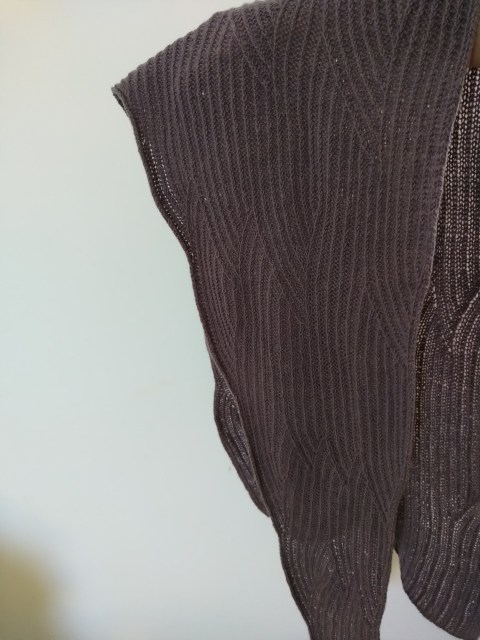The time has come for me to talk about this design.
Fukinsei – My Zen garden – shawl is my first-ever (and last !?) commissioned design. After Treasure knitting, a book on Nepal and Mongolia including 5 designs from Eri Shimizu, Nomad noos decided to make a more Japanese book, with the theme wabisabi and I was asked if I wanted to take part into it, not only as a technical editor but also as a designer.
Haven’t you ever heard the word wabisabi? It’s in fact extremely difficult to define! but I’ll try to explain it briefly.
Wabisabi is a Japanese aesthetic, born in the tea ceremony around the XV-XVI centuries. The tea masters of that time, influenced by Zen philosophy, began to value simple tea wares created by local artisans, instead of very refined and expensive artistic bowls imported from China. They tried to discover beauty in simple, imperfect and impermanent things, and this aesthetic has not only influenced all of the artistic domains in Japan but become a kind of philosophy.
This aesthetic is deeply rooted in our spirit. You may know that our crafts are governed by another concept of craftsmanship: they are not perfect – not perfectly round or symmetric – and we can even see the artisan’s fingerprints on the objects. You may also know that we Japanese love cherry blossoms. We appreciate their beauty all the more because they don’t last.
As a philosophy, wabisabi teaches you to live the present instant fully, a kind of carpe diem though not in an epicurean sense of the term, and find contentment in what you have, as nothing is permanent. In the tea ceremony too, they change utensils, interior decoration (flower arrangement or kakemono) or pastry to eat with tea, closely following the evolution of seasons, to feel the instant fully and to be in harmony with nature.
This is what I understood, reading a few books about wabisabi or the tea ceremony and asking a friend who practiced the tea ceremony. But as an average Japanese who has never practiced it, I would say, we know what is wabisabi or not, seeing objects, landscapes or architectures. We feel it in front of sober objects or scenery which give us a feeling of serenity.
So the first thing that came to my mind was the Zen garden of Ryoan-ji temple in Kyoto and its raked gravel representing waves. I do think that, in every Japanese’s heart, wabisabi is linked to the temples and landscapes in Kyoto, and water and its sound are part of it. We have the chance to live not so far from the sea – the Atlantic Ocean is less than an hour drive – and go to the sea regularly. We do nothing on the beach, just sitting in front of this stretch of water and lulled by the sound of waves coming in and out regularly, but in fact irregularly – because no waves are the same.
So I wanted to design a shawl with my Japanese side and the life I have here blended in, with waves motif overall. As a Japanese, I evidently had seigai-ha – Japanese geometric wave motif in my mind, but the waves should be freer, like real waves, to follow in that way the sub-theme fukinsei, irregularity, I was given.
It starts with a few stitches and the waves are drawn in twisted ribbing.

The waves are formed and reformed with increases and decreases. The principle of the shawl is simple and regular but I have to admit that I drew the waves quite freely, pushing the concept of irregularity to the end.

The yarn I received was Dry Desert Camel, a light-fingering yarn made from 100% camel and hand-spun by Nepalese.

It’s incredibly thin and regular for a hand-spun yarn, but it is not as perfect as a machine-produced yarn and rejoins in this point the concept of wabisabi. In hand, it was a pleasure to work with, very soft, and thanks to the high-twist, it has a crisp stitch definition and well renders the movements of the waves. The resulting fabric is very light and drapey.



It is rather a shawlette than a shawl, but large enough to be wrapped around your shoulders to add a layer of warmth.

And thank to the lightness of the fabric, you can also use it as a scarf.

The pattern is currently available only in Wabisabi book. Please check Nomad noos’s website – you can also find the yarn kit for the shawl. They have wholesalers around the world and some carry the book too! Check the store locater’s page.
We are preparing a little surprise. In the meantime, I wish you all a happy holiday season!

